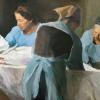
A Soul Wandering (monotype print, 2006). Friedman says of this work: In the 30 days after burial, Judaism views the soul as existing in a state of confusion, moving back and forth from its grave to its former home before ascending.
"Our society is ready to have open conversations about death," says artist Karen Benioff Friedman '86.
This winter, San Francisco’s Sinai Memorial Chapel held an exhibition of her paintings, drawings and prints that depict taharah, the Jewish ritual for washing, purifying and dressing the dead.
Friedman first learned about taharah in 2001, when her congregation in Berkeley, Calif., started a chevra kadisha, a group that performs tasks, among them taharah, in service to those who are sick and those who have died. Then, in 2004, a close friend with terminal cancer asked Friedman to be on her taharah team. Friedman has regularly performed taharah ever since.
At Amherst, Friedman began as a geology major. She took a leave from college to spend time in Jerusalem, and after returning from that experience, she felt lost. At her mother’s suggestion, she took an art class, and that was it: She quickly changed her major to fine arts.
Friedman went on to dabble in art while raising her children. About a decade ago, she enrolled in art school at Golden Gate Atelier. She was a student there when her husband found an intriguing reference to a series of paintings from Prague in the late 18th century.
Those images depict scenes from the work of the Prague chevra kadisha. Friedman wondered who else had painted these practices over the years. The answer was: no one. Inspired, she began tentatively with thumbnail drawings. When she finished art school, she dove into the project in her home studio.
We hope to send her off to leave this world peacefully. We are the last hands that will touch her,” Friedman says.
“The goal is to echo the Prague paintings,” she says. Today, she is actively creating new images for the series (most can be viewed at KarenBenioffFriedman.com), with friends often posing as subjects. The works are both emotionally resonant and educational. When European Jews immigrated to the United States in the 19th and 20th centuries, most left taharah behind. “Now we’re relearning it and reteaching it,” Friedman says.
Her series reveals the deep respect taharah teams have for the dead, and it does so in a subtly feminist manner. While the Prague paintings are about men, “I’m painting what I know,” Friedman says, “and what I know is the women’s taharah team.” So far, she says, the piece that’s garnered the most attention is of the angel of death cradling an infant. “Women have approached me and said it makes them think of the child they lost or the abortion they had,” she says. “I think there’s a need for people to talk about it, to be heard.”
Works by Karen Benioff Friedman (4)

Placing the Metah Into Her Casket (oil on canvas, 2019). After she is washed, purified and dressed in a shroud, the deceased is placed in a plain wooden casket.

The Ritual of Purification: Pouring the Second Bucket (oil on canvas, 2017). The taharah ritual requires three buckets of cold water to be poured over the deceased in a continuous flow.

Angels of Mercy Embrace the Deceased (oil on canvas, 2023). “May the angels of mercy embrace the deceased” is a phrase from the liturgy of taharah, recited while preparing a body for burial.